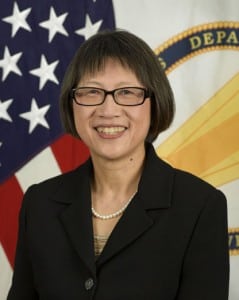Heidi Shyu, the nominee to serve as the Pentagon’s next top technology official, said Tuesday she wants to make it easier for small firms to work with the department on emerging technologies, to include addressing the “valley of death” in moving innovation from prototyping to programs of record.
Shyu, who once served as the Army’s acquisition executive, told the Senate Armed Services Committee (SASC) during her confirmation hearing the department should also assess its internal investment strategy to move on from having 70 percent of weapon systems costs allocated for legacy system sustainment.

“DoD should strive to flip this ratio and invest more in the development of new technologies than it does in the sustainment of legacy systems,” Shyu said. “Inside the department, DoD should avoid duplicating private sector research and focus its investment on the innovative technologies that DoD uniquely needs but that the commercial sector is not developing on its own.”
Sen. Jack Reed (D-R.I.) the SASC chair, pressed Shyu on changes she would like to see to the Pentagon’s Planning, Programming, Budgeting, and Execution (PPBE) process for allocating resources, responding that the department’s two-year planning cycle to establish programs of record contributes to the technology “valley of death” challenge.
“Unless you have the foresight to understand that the technology is going to be mature within two years time to plan it into your [Program Objective Memorandum], there’s a two-year gap,” Shyu said. “[Even then], by the time you get the money to buy that technology, it’s two years old now. So there is absolutely a gap in terms of our ability to buy the latest technology.”
Shyu’s comments echoed a similar sentiment from lead research and engineering (R&E) officials from the military services who testified to SASC last week that additional budget flexibility would improve their ability to more rapidly get after new capability innovation efforts, particularly those coming from non-traditional partners and small businesses (Defense Daily, May 20).
In response to several lawmakers’ questions on creating additional opportunities to bring in small businesses, Shyu urged the panel to continue the Small Business Innovation Research program when it’s up for reauthorization in 2022 and said she would meet with non-traditional partners to understand their impediments to working with the department.
“You are absolutely 100 percent right. [The Pentagon] is a giant fortress and they have no idea where the door is,” Shyu said.
Shyu noted she specifically sees an opportunity to bring in small companies to work on ideas to reduce fuel use and the overall logistics burden to get after climate change-related initiatives.
“If confirmed, I would like to help these types of companies to advance their technology maturity so we can deliver unprecedented capabilities. And it will absolutely help the issue of climate change because you’re reducing the logistics burden,” Shyu said.
President Joe Biden announced in late April he had tapped Shyu to serve as the next under secretary of defense for R&E, which would see her returning to the Pentagon following her role as the Army’s top acquisition official from September 2012 to January 2016 (Defense Daily, April 27).
Shyu, who is currently a consultant for over a dozen companies and is a member of the Aerospace Corporation’s board of trustees, would oversee the department’s expansive technology development portfolio, to include hypersonic weapons and directed energy initiatives.